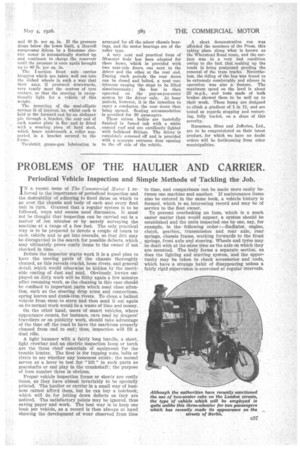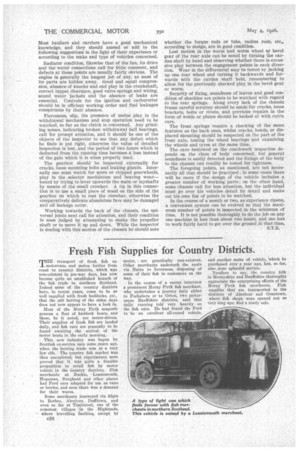PROBLEMS 'OF THE HAULIER AND CARRIER.
Page 21

Page 22

If you've noticed an error in this article please click here to report it so we can fix it.
Periodical Vehicle Inspection and Simple Methods of Tackling the Job.
IN a recent issue of The Conmercial Motor I referred to the importance of periodical inspection and the desirability of adhering to fixed dates on which to go over the chassis and body of each anti every fleet unit in turn. Granted that a regular system is to be followed, ways and means need discussion. It must not he thought that inspection can be carried out in a matter of ten minutes or by merely surveying the machine at a range of a few feet. The only practical • way is to be prepared to devote a couple of bouts to each vehicle and to get into overalls, so that dirt may be disregarded in the search for possible defects, which may ultimately, prove costly items to the owner if not checked in time.
Before the inspector starts work it is a good plan to have the moving parts of the chassis -thoroughly cleaned, as this reveals crack, loose rivets, and general detail, which would otherwise be hidden by the inevitable coating of dust and mud. Obviously, lorries employed on dirty work will be filthy again a few minutes after resuming work, so the cleaning in this case should be confined to important parts which need close attention, such as the steering drop arms and connections, spring leaves and durnb-iron 'rivets. To clean a ballast vehicle from stem to Stern and then send it out again• on its normal work would be a waste of time and money.
On the other hand, users of smart vehicles, where appearance counts, for instance, cars used by drapers' travellers or on publicity work, should take advantage of the time off the road to have the machines properly cleaned from end to end ; thus, inspection will fill a dual rOle.
A light hammer with a fairly long handle, a short, light crowbar and an electric inspection Lamp or torch are the three chief essentials of equipment for the trouble hunter. The first is for tapping nuts, bolts or rivets to see whether any, looseness exists ; the second serves as a lever to test for "lift" in such parts as gearshafts or end play in the crankshaft ; the purpose of item number three is obvious.
Proper vehicle inspection forms or sheets are costly items, as they have almost invariably to be specially printed. The haulier or carrier in a small way of business cannot afford them, but he can buy a notebook, which will do for jotting down defects as they are noticed. The satisfactory points may be ignored, thus saving paper and work. The best way is to keep one book per vehicle, as a record is then always at hand showing the development of wear observed from time to time, and comparisons can be made more easily between one machine and another. If maintenance items also be entered in the same book, a vehicle history is formed, which is an interesting record and may be of service to the fleet owner.
To prevent overlooking an item, which is a much easier matter than would appear, a system should be established and the units inspected one by one, say, for example, in the following order :—Radiator, engine, clutch, gearbox, transmission and rear axle, rear springs, chassis frame, working forwards to the front springs, front axle and steering. 'Wheels and tyres may be dealt with at the mime time as the axle on which they are mounted. The body forms a separate section, as does the lighting and starting system, and the opportunity may be taken to check accessories and tools, which have a strange habit of disappearing unless a fairly rigid supervision is exercised at regular intervals. Most hauliers and carriers have a good mechanical knowledge, and they should amend or add to the following suggestions in the light of their experience or according to the make and type of vehicles concerned.
Radiator condition, likewise that of the fan, its drive and the water connections call for little comment, and defects at these points are usually fairly obvious. The engine is generally the longest job of any, as most of its parts are hidden away. Good and equal compression, absence of knocks and end play in the crankshaft, correct tappet clearance, good valve springs and wiring, sound water jackets and the absence of leaks are essential. Controls for the ignition and carburetter should be in efficient working order and fuel leakages conspicuous by their absence.
Fierceness, slip, the presence of undue play in the withdrawal mechanism and stop operation need to be watched, so far as the clutch is concerned. Any grinding noises, indicating broken withdrawal ball bearings, call for prompt attention, and it should be one of the objects of the inspector to see that any defect which he finds is put right, otherwise the value of detailed inspection is lost, and the period of two hours which is deducted from the running time becomes a loss instead of the gain which it is when properly used.
The gearbox should be inspected externally for cracks, loose mounting bolts and leaking glands. Internally one must watch for worn or chipped gearwheels, play in the selector mechanism and bearing wear— tested by trying to lever upwards the main or layshafts by means of the small crowbar. A tip in this connection is to use a small piece of wood on the side of the gearbox on which to rest the crowbar, otherwise the comparatively delicate aluminium face may be damaged and oil leakage occur.
Working towards tile back of the chassis, the universal joints next call for attention, and their condition is soon judged by attempting to shake the propeller shaft or to move it up and down. While the inspector is dealing with this section of the chassis he should note whether the torque rods or tube, radius rods, etc., according to design, are in good condition.
Lost motion in the worm and worm wheel or bevel gear of the rear axle can be noted by turning the cardan shaft by hand and observing whether there is excessive play between the engagement points in each direction. Wear in the differential may be tested by jacking up one rear wheel and turning it backwards and forwards with the cardan shaft held, remembering to allow for the previously checked play in the bevel gear or worm.
Security of fixing, soundness of leaves and good condition of shackles are points to be watched with regard to the rear springs. Along every inch of the chassis frame careful scrutiny should be made for cracks, loose brackets, bolts or rivets, and previous repairs in the form of welds or plates should be looked at with extra care.
The front springs require a checking of the same features as the back ones, whilst cracks, bends, or displaced mounting should be suspected on the part of the front axle, testing the wheel bearings and examining the wheels and tyres at the same time.
The care bestowed on the coachwork inspection depends on the class of body concerned, but general soundness is easily detected and the fixings of the body to the chassis can readily be tested for tightness.
The foregoing points, as mentioned, are not necessarily all that should be practised ; in some cases there will be more if the design of the vehicle• includes a greater number of working parts; on the other, hand, some chassis call for less attention, but the individual must go over his vehicles detail by detail and make out his own list of points to be watched.
In the course of a month or two, as experience ripens, a convenient system can be evolved so that the maximum number of points is inspected in the minimum of time. It is not possible thoroughly to do the job on any one machine in less than about two hours, and one has to work fairly hard to get over the ground in that time.
S.T.R.
































